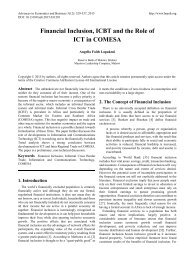FD
gvti301SEaf
gvti301SEaf
You also want an ePaper? Increase the reach of your titles
YUMPU automatically turns print PDFs into web optimized ePapers that Google loves.
Off Its Pinnacle<br />
Robert J. Gordon<br />
THE average American family of<br />
1870 would have been astounded<br />
by the living standards of their 1970<br />
descendants. From electric lighting<br />
to healthier and longer life spans, in but a century<br />
the American standard of living changed<br />
dramatically from the primitive conditions<br />
of 1870 to the modern world of today. Those<br />
sweeping improvements were in no small way<br />
due to technological changes that may never<br />
be rivaled for their broad impact on growth,<br />
productivity, and well-being.<br />
My recently published book, The Rise and<br />
Fall of American Growth, chronicles those<br />
changes, examines their sources, and looks<br />
at why productivity grew rapidly before 1970<br />
and much more slowly since then. It also<br />
forecasts muted growth in productivity and<br />
income per person from 2015 to 2040.<br />
revolutionary century after the U.S. Civil War<br />
was made possible by a unique clustering, in<br />
the late 19th century, of “great inventions,”<br />
principal among which were electricity and<br />
the internal combustion engine.<br />
The first industrial revolution, between<br />
1770 and 1830, witnessed the arrival of the<br />
steam engine, railroads, steamships, and<br />
mechanized cotton spinning and weaving.<br />
The most important industrial revolution<br />
was the second, with inventions centered on<br />
Is the United<br />
States entering<br />
a period of<br />
sustained<br />
low economic<br />
growth?<br />
The special century<br />
The 100 years after 1870 witnessed an economic<br />
revolution in which households were<br />
freed from an unremitting daily grind of<br />
painful manual labor, household drudgery,<br />
darkness, isolation, and early death. In only<br />
a century daily life changed beyond recognition.<br />
Manual outdoor jobs were replaced<br />
by work in air-conditioned environments,<br />
housework was increasingly performed by<br />
electric appliances, darkness was replaced by<br />
light, and isolation was replaced not just by<br />
travel, but also by color television images that<br />
brought the world into the living room. Most<br />
important, a newborn infant could expect to<br />
live not to age 45, but to age 72. The economic<br />
revolution of 1870 to 1970 was unique in<br />
human history.<br />
The foundation of the book’s analysis is that<br />
economic growth is not a steady process that<br />
creates economic advance at an even, regular<br />
pace. Instead, progress occurs much more<br />
rapidly in some eras than in others. There was<br />
virtually no economic growth for millennia<br />
until 1770, only slow growth in the transition<br />
century before 1870, and remarkably rapid<br />
growth in the century ending in 1970. Growth<br />
has been slower since then because some<br />
inventions are more important than others. The<br />
Workers put the finishing touches on a 1949 Ford sedan.<br />
Finance & Development June 2016 33














